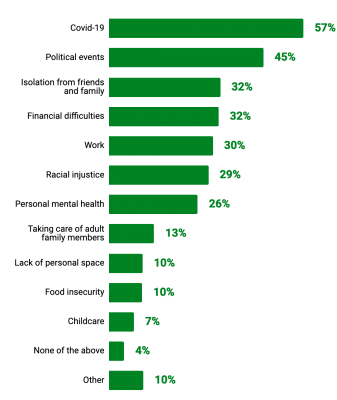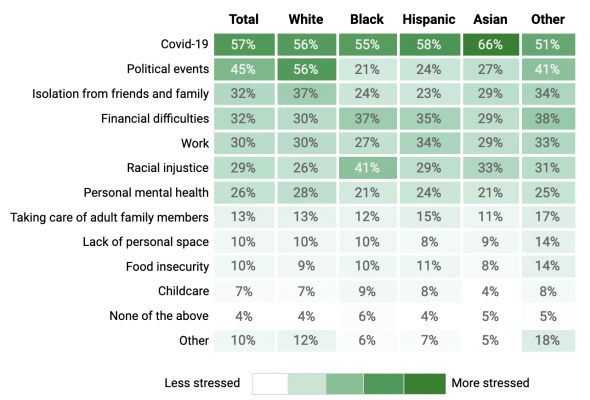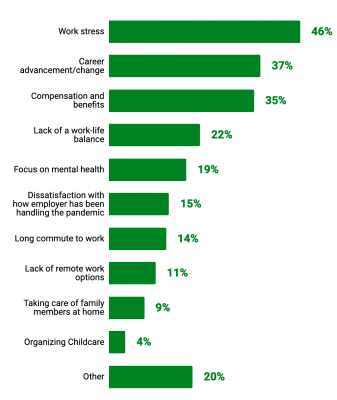Pandemic and politics the main sources of stress for Americans within the last year
Within the past year, Covid-19 and politics were among the leading causes of stress nationwide. Nearly three in five (57%) Americans say they were stressed due to the pandemic, and slightly less than half (45%) due to politics. Almost one in three reported isolation from others (32%), financial difficulties (32%), and work (30%) as a source of stress, followed by racial injustice (29%) and personal mental health (26%).
Causes of Stress Within the Past Year

Sources of stress, however, differed among Americans:
- Women were more likely than men to be stressed from Covid-19 (61% vs. 52%), social isolation (37% vs. 28%), racial injustice (33% vs. 25%), financial difficulties (35% vs 28%), and their mental health (32% vs. 20%)
- Nearly one in five parents (17%) of children 18 experienced stress related to childcare
- Racial injustice was a leading cause of stress (41%) for Blacks, trailing only Covid-19 (55%)
- Hispanics and Blacks were also more likely to be stressed due to financial difficulties (35% and 37% respectively), compared with Americans overall (32%)
Sources of Stress By Race/Ethnicity

Work-life balance is top of mind for remote workers, while social interactions drive the return to work
Currently, roughly one third (34%) of all employed Americans say they are working remotely at least some of the time, including 17% who are working completely remotely. Once the pandemic subsides, however, a mere 7% of workers expect to be working remotely full time.
- Among those currently working remotely full time, 34% will continue to work remotely, 38% will work a mix of both in person and remotely, and 13% will return to work in person. About one in seven (15%) are unsure of what their post-pandemic work arrangements will look like.
- Among those currently working both in person and remotely, more than a quarter (27%) are expected to return to working fully in person. The majority (58%), however, will continue with their hybrid work models, while 12% are unsure.
- The vast majority (90%) of those currently working in person will continue to do so after the pandemic, with a small minority unsure (5%) or working in a hybrid model (3%).
Expected Post-Pandemic Work Arrangement by Current Arrangement
Workers who want to work full time remotely after the pandemic cite work-life balance (66%), schedule flexibility (57%), job productivity (49%), and distance to their workplace (41%) as the main reasons for their preference.
- Two in five (38%) parents cite childcare as a leading reason for wanting to work remotely
- Workers aged 40 and younger are much more likely than those aged 41 and older to prefer remote work due to childcare (32% vs. 9%) and taking care of family members (26% vs 19%).
Reasons for Preferring Remote Work
Work-life balance (67%) and social interactions with others (50%) are the most common reasons for those who prefer a hybrid work arrangement, while more than half of workers who favor working in person cite social interaction with others (58%) and job productivity (52%) for their preference.
Lack of work schedule flexibility, long commutes, and decreased work-life balance the main concerns for the return to work
After a year of navigating new workplace policies and work arrangements, the return to work is not without concerns. Among those who are going back to their physical workplaces (either part time or full time), two in five (40%) say they are ‘somewhat dreading’ or ‘very much dreading’ returning to work in person. The overwhelming majority (80%) have at least some degree of concern about returning, with only a small minority (20%) not concerned about returning.
- 40% are concerned with a less flexible work schedule
- 36% are returning to a long commute to work
- 35% expect a decrease in work-life balance
- 29% are concerned about getting exposed to the coronavirus at work
- 21% of parents are concerned about their childcare arrangements
- 19% believe they will be less productive in their jobs
- 18% predict a negative impact on their mental health
Getting exposed to the coronavirus at work is the most common worry (36%) among Black workers who are returning in person, followed by a long commute (28%) and a less flexible work schedule (24%). Concern over taking care of family members at home is also more prevalent among this group compared to workers overall (18% vs. 13%).
A quarter of all workers likely to leave their current jobs in the next 6 months, mostly due to stress from work
Some workers are also reconsidering their future with their current workplaces. A quarter (25%) of working Americans say they are ‘very likely’ or ‘somewhat likely’ to leave their current jobs within the next 6 months, with Gen Z (46%) and Black Americans (34%) much more likely than the rest of the population. Among those who are likely to leave:
- Nearly half (46%) cite stress from work playing a role in their desire to leave
- More than a third (37%) are looking to advance or change their careers, and a similar proportion (35%) are seeking better compensation and work benefits
- 22% cite the lack of a work-life balance in their current roles
- 19% want to focus on their mental health
- 15% are unsatisfied with how their employer has handled the pandemic
- 14% are hoping to leave due to a long commute
- 11% note the lack of remote work options
- 9% have to take care of family members at home
Reasons for Leaving Job in Next 6 Months

Workers who prefer to work remotely are much more likely to cite a lack of remote work options (34%) as a reason for wanting to leave their jobs, highlighting the growing embrace of the work arrangement among the workforce. Not all employers, however, are aligned with what workers’ want:
- Less than half (42%) of those who prefer to work a mix of both in person and remotely expect to do so once the pandemic subsides, with a similar portion (41%) expecting to work in person full time.
- Only one third (33%) of those who would rather work fully remote will have their preferred arrangement after Covid, as the rest return to working in person part time (28%), full time (21%), or are unsure (18%).
More than 1 in 4 workers report a decline in their mental health throughout the pandemicworkers report a decline in their mental health throughout the pandemic
As workers spent the last year facing different challenges, over a quarter (28%) say their mental health declined throughout the last year when compared to before the pandemic. One in six (16%) report an improvement in their mental health, and the majority (56%) report no difference.
- Women are more likely than men to report a decline (32% vs. 24%)
- Younger workers, especially those aged 18-34, experienced greater levels of change in their mental health than those who were older. Roughly a third (33%) reported deterioration, about a quarter (24%) experienced an improvement. Only about 2 in 5 (42%) said the state of their mental health was about the same as before Covid.
- Mental health among older workers were largely the same throughout the pandemic: 60% of 35-64 and 73% of 65+ reported no change in their mental health.
Workers are mostly satisfied with the mental health support from their workplace, but many lack options apart from health insurance
Workers also expect mental health support from their employers: three in four (75%) say it is ‘very important’ or ‘important’ for their workplace to provide mental health benefits.
- This is especially apparent among minority employees: 85% of Black, 83% of Hispanic, and 87% of Asian workers say that this type of support is important, compared with 69% of White employees
- Women are more likely than men to view employer support as important (81% vs. 68%)
- Those who identify as gay, lesbian, or bisexual value mental health benefits more than the overall population (85% vs. 75%)
Employers are largely doing their part to support workers’ mental health: 73% ‘strongly agree’ or ‘somewhat agree’ that the health insurance offered by their employer meets their mental health needs. A substantial minority (31%), however, do not feel that they can openly discuss their mental health needs with their manager at work.
Health insurance is the most common mental health resource provided to workers, with 54% saying that their employer provides the benefit. Employee assistance programs (28%), flexible work schedules (27%), and wellness and mental health activities (21%) are also available to some, but only a small minority say they are provided strength and resiliency training (10%), employee resource groups (10%), mental health days (10%), and digital health and wellness services (9%).
Digital health and wellness services a rare benefit offered by employers
Despite the numerous digital health and wellness services emerging in the past few years, very few workplaces offer such a benefit. Calm, a mobile app that helps with meditation and sleep, is the most popular offering, yet barely reaching 6% of all workers. Services that provide on-demand mental health care, such as Modern Health, Mindstrong, Ginger, and Lyra Health are also scarcely available to employees, offered by less than 5% of employers.
- Black and Asian workers are more likely to have workplaces that offer a digital health service: 11% of Blacks have employer-provided access to Calm and Modern Health, while Asians also see a similar level of offerings for Calm (13%)
Read more about our polling methodology here.



